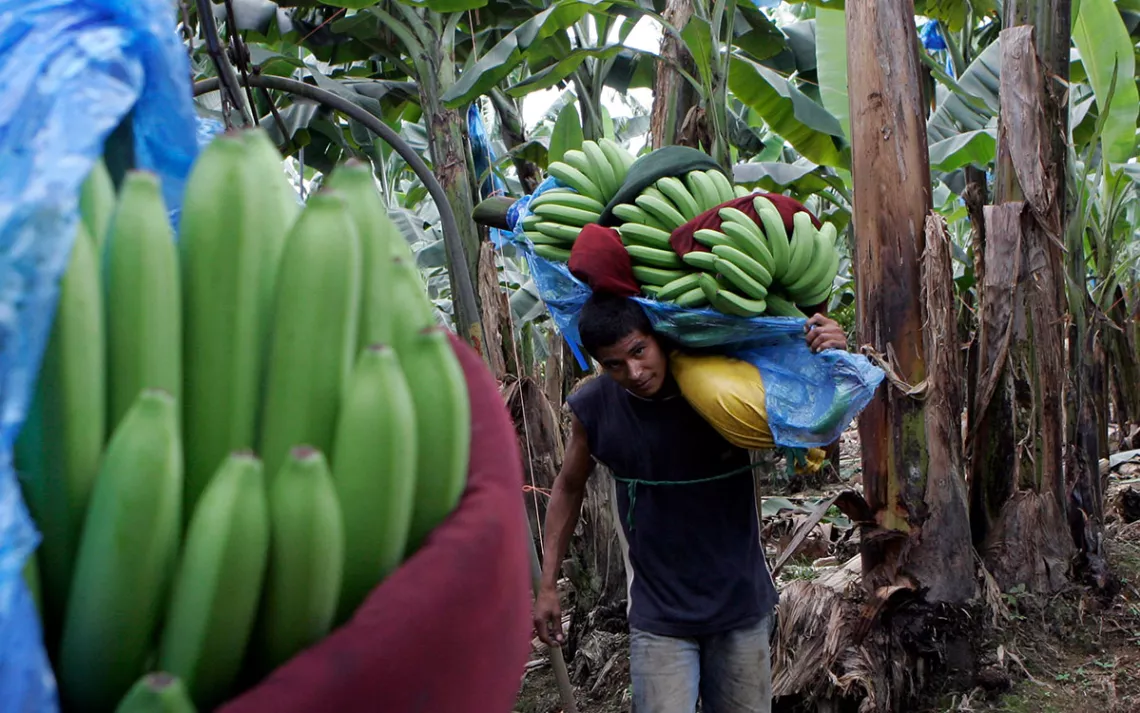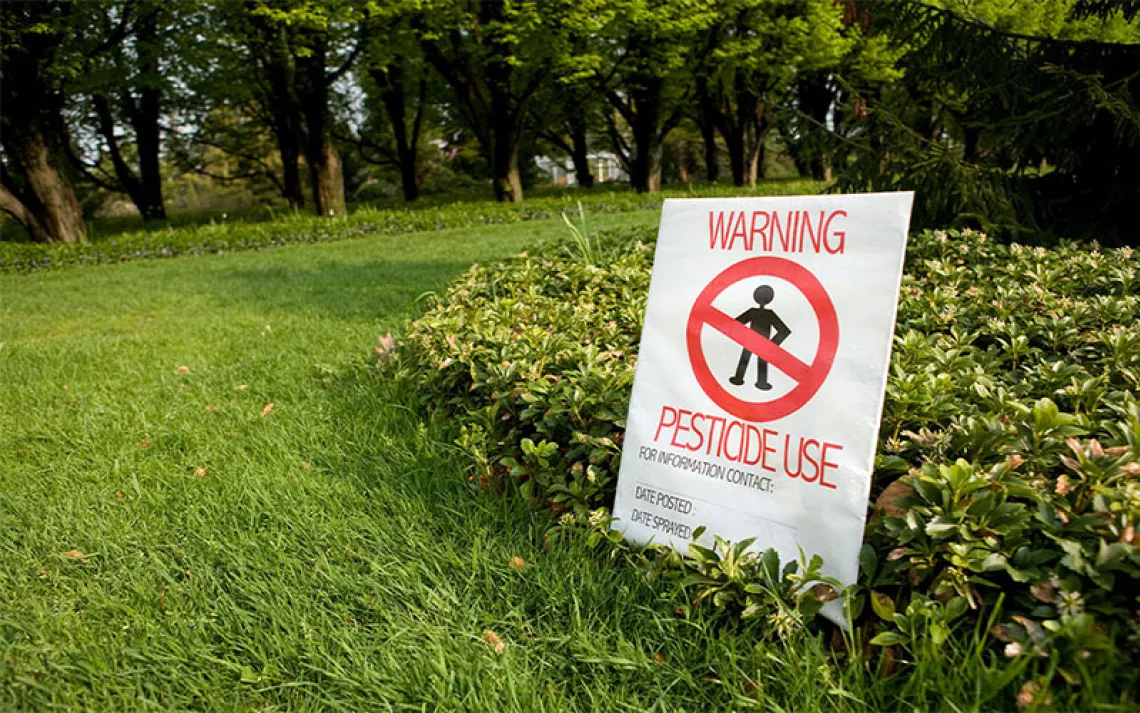Everything Isn’t Pura Vida in Costa Rica
The country’s banana industry is heavily reliant on chemical pesticides that threaten the environment and public health

Photo by Kent Gilbert via AP
The drive down Costa Rica’s Highway 36, which traces the Caribbean coast toward the Panama border town of Sixaloa, is lined with seemingly endless banana plantations. From the air, the farms stretch on for miles—a sea of manicured green, the trees tidy and lined in rows. From the road, the lush green fronds hang over one another and onto the worn two-lane highway, forming an impregnable wall of thick vegetation.
The bananas themselves, however, are often hard to see. They are covered in blue plastic bags. This helps protect the precious fruit, and also keeps them constantly fumigated to destroy pests.
The blue bags are the most visible sign of the intense industrialization of banana production on Costa Rica’s farms. Costa Rica is the world’s third-largest exporter of bananas. In 2021, banana exports reached $1.23 billion, and some 28,000 people work on banana farms across the country today.
But banana plants are susceptible to a host of illnesses and blights. That’s because banana plants don’t reproduce by seed. They produce via rhizomes, which have several buds. In other words, banana trees are essentially clones, lacking genetic diversity, which makes them especially susceptible to pests and diseases. The most common variety is the Cavendish banana. This is the banana plant that stretches for miles across Costa Rica’s Caribbean lowlands and the fruit that most often you find in your supermarket aisles.
The intensive use of pesticides on Costa Rican banana farms here is staggering. Toxic chemicals—including many pesticides banned elsewhere in the world—have poisoned people and ecosystems. They’ve caused birth defects, killed fish and wildlife, and they continue to be sprayed at massive levels, even if they are largely unnoticed by the 2.3 million foreign tourists that visit the country in 2022.
Mentions of Costa Rica often conjures up images of cloud forests, pristine jungle, and gorgeous beaches. And it’s true that the country prides itself on its ecotourism and nature reserves.
But in contrast to its eco-groovy image and pura vida vibe, Costa Rica has one of the highest rates of pesticide use per capita of anywhere in the world. In the mornings, before the afternoon rains, crop dusters fly low over the fields. The buzz from the propellers wash over the countryside like a swarm of bees.
On a warm, overcast afternoon in September, the head of the banana workers’ union at Chiquita’s Tayrona plantation, Carlos Quiroz, walked me through the process of pesticide application on the farm, listing off an alphabet soup of chemicals applied to the land over the growth cycle.
“Before they plant the banana, they use several types of herbicides, be it reglone, be it gramozome. Be it biokill, be it a permanent herbicide that wipes the land clean for six months and nothing is born after it is applied,” Quiroz said. “When the little plants are growing, they start to apply the nematicides—three different types.”
Nematicides are a type of chemical pesticide used to kill parasitic nematodes, or roundworms. Then there’s the areal fumigation to control the fungal disease black sigatoka, plus a whole host of other insecticides. Finally, there’s the chemical fumigation bags that cover the fruit as it grows on the tree. Quiroz says a total of eight or nine different pesticides are used on each crop throughout the year.
“I do believe the banana is one of the agricultural products where the highest level of chemicals are applied,” he said. “Because from the moment it’s planted to the moment it’s producing, it is controlled by chemicals.”
According to a recent study on pesticides in Costa Rica published in the scientific journal Environment International, 79 different pesticide molecules are authorized in Costa Rica to be applied on banana plantations. Those pesticides are available in 818 products. Among them are 43 fungicides; 12 herbicides for weed control; six insecticides sprayed on the plants; another seven insecticides placed in the blue bags wrapped around the growing bananas; and eight nematicides. Many of the products are banned in the European Union and the United States.
"The pesticide load is much higher—10 times more—than what we have in temperate regions,” said Carsten A. Brühl, a specialist on pesticides at Germany's University of Koblenz-Landau, who has studied pesticide use extensively in Costa Rica and participated in the Environment International study.
"For example, [on] wine in Germany we use eight kilograms of pesticides, mainly fungicides per hectare, each year. And on banana plantations it can be up to 60 or 70 kilos of product. So that's 10 times more, and the reason is because you apply every week in Costa Rica,” he said.
Banana workers at the Chiquita farm say the company routinely directs them to apply chemicals without labels or without explanation of the safety concerns. Union leaders say the company only encourages workers to use protective gear when there is some sort of an audit or visit from supervisors or a regulatory agency.
Sierra tried to reach out to Chiquita in both Costa Rica and the head office in Switzerland for this story. At the time of publication, Chiquita had not responded to our questions.
Valdivieso Miller has worked for 33 years with the chemical bags on banana farms in this region of Costa Rica. He’s stout, with thick, powerful hands from a lifetime laboring the fields and a shade of skin that tells of an Indigenous heritage. Miller said he often gets toxic substances in his eyes when he’s moving the banana leaves to bag the bananas, after plants have been dusted from the planes in the morning.
“I can’t see far,” he said. “I feel like my eyes are blocked with smoke. I can't recognize people from afar, and I know it’s from working with the chemicals. They might say, no. Or that there’s no way to prove it. But I know that it’s because of the chemicals.”
Union leaders say more than 10 percent of the men who work with the banana bags have issues with their eyes: cataracts or partial blindness, likely due to the chemicals. Farm workers elsewhere say their fingernails have fallen out from chemical exposure.
The pesticides also impact the surrounding community. In Matina County, near the regional capital of Limon, half of elementary schools are less than 500 feet from banana fields. One 2014 study of 451 pregnant women living near bananas plantations showed they all had highly elevated concentrations of the fungicide mancozeb, which is sprayed on the fields from above.
Sterility and birth defects are not uncommon. Some local residents say crop fumigations have caused cancer. Between 2010 and 2020, 58 people were reported to have died from pesticide poisoning.
"It’s really concerning," said Silvia Echeverría-Sáenz, a biologist and researcher at the National University’s Central American Institute for Studies on Toxic Substances. "The pesticides are meant to control plagues on the plantation, but they are exercising their toxic effect off the plantations. We have identified pesticides across many layers of the environment: air, water, soil. And also in subterranean water.”
In 2022, Costa Rica’s Health Ministry ordered residents of the town of Cipreses—up the mountains toward the capital San Jose—to stop consuming their drinking water after it was found to contain the fungicide chlorothalonil at levels up to 200 times higher than the safe limit. The product is banned in the EU, but until late last year, it was commonly used on farms across Costa Rica.
Chlorothalonil was prohibited by presidential decree on November 30, 2023. This came on the heels of another presidential decree in late 2022 that updated the agricultural pesticide and fertilizer code.
In a written statement to Sierra, Costa Rica’s Environment Ministry said that the update was decades in the making and that it will allow the country to register new, more efficient products that have already been approved by other member countries of the Organization for Economic Cooperation and Development. Costa Rica joined the OECD in 2021.
“The Ministry of Environment guarantees that pesticides and other agricultural inputs that are registered in the country do not represent an unacceptable risk to the environment and mitigation measures for associated risks are identified and promoted," the Environment Ministry wrote to Sierra. "Risk mitigation measures must be included in product pamphlets so that users have clear instructions for their use, reducing impacts outside the areas of cultivation.”
“[Costa Rica] also prohibits the use of harmful agrochemicals that are already prohibited in at least 80 percent of OECD countries,” said the statement.
Nevertheless, Echeverría-Sáenz says the pesticide use per hectare on Costa Rican farms is 400 percent what it was 30 or 40 years ago, in part due to greater pest resistance to the products. The increase in spraying is taking a toll on the local ecosystem.
“According to water samples from rivers that have high concentrations of pesticides, we have seen toxic impact such as mortalities. Organisms have had lower reproduction. We have seen growth defects. And changes in the ecosystems near large cultivations, such as decreasing diversity,” she said.
The Jaguar Rescue Center is a private animal rehabilitation center located about a dozen miles from the banana farms in Sixaola. The center treats roughly a thousand animals a year and specializes in helping animals return to the wild. But the staff there has two resident sloths that can’t leave: Turanga and Mufasa. They are incredibly adorable but are about half the size they should be. That’s because they both have stunted growth and were born with birth defects, including a bowel deformity. They would not last on their own in the forest.
The sloths were found in two different locations along the Caribbean coast, both in the middle of intensive banana producing regions. The Sloth Sanctuary of Costa Rica has seen a similar trend, receiving nine orphaned baby sloths showing deformities, including missing fingers and toes, malformed ears, misshapen limbs, and partial or full albinism.
Carlos Gutierrez, a biologist and guide at the Jaguar Rescue Center, said he believes the pesticides are to blame.
“It's really disturbing and nothing is being down about it,” he said. “The owners of these companies sell Costa Rica as a 'green' place,' but they don’t care about these things."
The pesticides are not just coming from banana farms. Costa Rica has many cash crops: coffee, rice, sugar. The next time you go to the supermarket and pick out a nice ripe pineapple, chances are it’s from Costa Rica. Eighty-six percent of pineapples sold in the United States come from Costa Rica, which is the top exporter of the fruit on the planet. Roughly 30,000 people are directly employed in the pineapple industry and the level of pesticide use is just as intensive as on the banana farms.
The widespread pesticide pollution in the small, Central American country reveals a great contradiction with Costa Rica’s green image. As numerous experts interviewed for this story underscored, the pesticide use does not negate the fact that the country has made huge strides toward environmental protection. Costa Rica has been a pioneer in conservation, and a quarter of the country is protected in national parks and reserves. Costa Rica is home to between 4 and 5 percent of the planet’s biodiversity. Ninety-eight percent of Costa Rica's energy is renewable.
“Costa Ricans really embrace the idea of being an eco-country,” Brühl said. “This is the one country that turned around forestation. They were deforested and they reforested. That's an exceptional thing. Many, many countries can learn from Costa Rica, but on the other hand there is this pesticide issue.”
Researcher Echeverría-Sáenz explained that at the root of this contradiction is the importance the agricultural sector has traditionally played as a pillar of the country’s economy.
"They have justified practices that have been inadequate in terms of conservation but that favor agricultural production,” she said. "As a motor of employment, income, and the development of the country, they have pardoned agricultural practices that could be detrimental for the environment, because they have weighed them against the economic contribution that those crops make for the country."
Echeverría-Sáenz said change is necessary and there are alternatives to the status quo. For example, growers could practice crop rotation, shade growing, and sustainable agricultural management systems. They could use organic fertilizer, by leaving leaves and plant matter to decompose into the soil. And there are examples of sustainable banana farms, even in Costa Rica.
In 2022, the UN warned Costa Rica it needed to cut back on its pesticide dependence. But there are many obstacles to doing so.
"When the producers are asked about who visits them most in their fields, it is clear that the sellers of agrochemical products visit them more than specialists from the Ministry of Agriculture,” said Maria Arias Andres, also a researcher at the Central American Institute for Studies on Toxic Substances. "And the programs for promoting cultivation without pesticides, as well as organic certifications, remain limited and expensive for small and medium-sized producers.”
In other words, Costa Rica is likely to walk the tightrope of its environmental contradiction for many years to come.
 The Magazine of The Sierra Club
The Magazine of The Sierra Club



